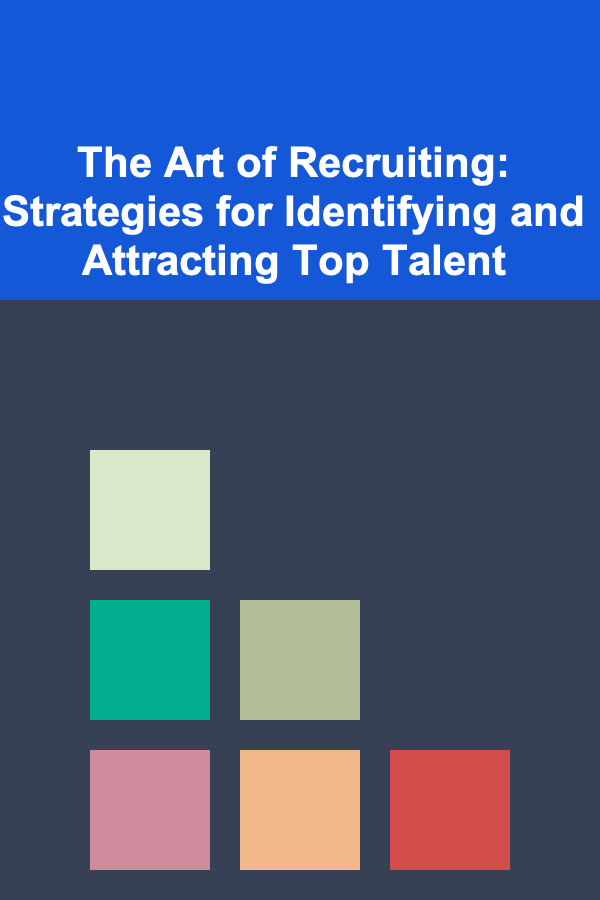
The Art of Recruiting: Strategies for Identifying and Attracting Top Talent
ebook include PDF & Audio bundle (Micro Guide)
$12.99$7.99
Limited Time Offer! Order within the next:

Recruiting top talent is an art form. It's not just about filling a vacancy---it's about attracting individuals who will elevate the organization, drive its success, and thrive within its culture. As competition for skilled professionals increases and the talent pool becomes more diverse, recruiters must refine their strategies to effectively identify and engage top-tier candidates. This guide will delve into the strategies and techniques that recruiters can leverage to successfully identify, attract, and hire the best talent.
Understand Your Organization's Needs
Before diving into any recruitment efforts, it's crucial to have a comprehensive understanding of your organization's culture, objectives, and long-term goals. Identifying and attracting top talent begins with a solid foundation. Every hire should not only meet the immediate needs of the company but also align with its future aspirations.
Actionable Tip: Collaborate with Hiring Managers
Work closely with hiring managers and key stakeholders to gain a deep understanding of the role's requirements, both technical and cultural. Consider factors such as:
- The specific skill sets required.
- The level of experience necessary.
- The type of personality and work style that complements your team and company culture. By aligning your recruitment efforts with the organization's overall strategy, you ensure that every hire contributes to the broader mission.
Define the Ideal Candidate Profile
Once you have a clear understanding of the role and organizational needs, it's time to define the ideal candidate profile. This goes beyond just creating a job description; it's about identifying the key attributes, qualifications, and competencies that will allow a candidate to succeed in the role.
Actionable Tip: Use a Competency-Based Approach
Create a list of core competencies that are essential for the position. These can include:
- Technical Skills: Knowledge and expertise specific to the role.
- Soft Skills: Communication, problem-solving, leadership, and teamwork abilities.
- Cultural Fit: A candidate's alignment with the organization's values, mission, and work environment.
A competency-based approach ensures that you are not just looking for someone with the right qualifications but someone who can thrive in your organization's specific context.
Build a Robust Employer Brand
In today's competitive job market, the best talent is often selective about where they work. A strong employer brand plays a pivotal role in attracting top candidates. Employer branding is the process of creating and promoting an image of your company as an attractive place to work, emphasizing its culture, values, and the unique benefits it offers.
Actionable Tip: Showcase Your Company Culture
Actively promote your company's values and culture through various channels. This can include:
- Social Media: Share behind-the-scenes insights, employee testimonials, and company achievements.
- Company Website: Create a dedicated careers page that highlights what makes your organization special, including employee stories and the work environment.
- Employee Advocacy: Encourage your employees to be brand ambassadors, sharing their experiences and promoting the company on social media and professional networks.
A well-established employer brand helps build trust and attraction with potential candidates even before they apply for a job. It creates a sense of pride among current employees and attracts candidates who resonate with your company's ethos.
Leverage Multiple Sourcing Channels
Once your brand is solid, the next step is sourcing candidates. Top talent can come from a variety of sources, so it's important to cast a wide net. Relying on just one or two channels may limit your access to diverse talent.
Actionable Tip: Use a Multi-Channel Sourcing Strategy
Consider leveraging a combination of these channels:
- Job Boards and Career Websites: Traditional job boards like LinkedIn, Indeed, and Glassdoor remain important sources of talent.
- Social Media Recruiting: Platforms such as LinkedIn, Twitter, and Instagram are excellent tools for engaging with both active and passive candidates. Create engaging posts to promote job openings and share relevant company content.
- Employee Referrals: Tap into your current workforce for referrals. Employees often know qualified individuals within their network who may be a good fit.
- Networking Events and Job Fairs: Engage with potential candidates in person through industry events, conferences, and job fairs. These are great opportunities to meet professionals who are actively looking or could be persuaded to make a career move.
- Recruitment Agencies: For specialized roles or hard-to-fill positions, working with recruitment agencies can speed up the process and bring in highly qualified candidates.
Using a multi-channel approach allows you to reach a broad pool of candidates and ensures you don't miss out on hidden talent.
Engage Passive Candidates
Not all top talent is actively seeking a new job. In fact, many of the best candidates are passive job seekers---individuals who are not currently looking for a job but would be open to new opportunities if the right offer came along. Engaging passive candidates requires a more strategic and thoughtful approach.
Actionable Tip: Build Relationships with Passive Candidates
Reach out to passive candidates through personalized communication. Instead of sending generic job postings, craft messages that focus on:
- The candidate's specific skills and experience that caught your eye.
- The benefits of the role and company, highlighting what makes it unique and attractive.
- A brief overview of potential career growth opportunities within your organization.
By nurturing relationships with passive candidates, you create a talent pipeline that can be tapped into when a relevant role becomes available. Regularly engage with them through email updates, newsletters, or invitations to industry events.
Streamline the Screening and Interview Process
The screening and interview process is crucial for assessing whether a candidate has the right skills, qualifications, and cultural fit for the company. A well-organized and structured interview process not only helps identify top talent but also leaves a positive impression on candidates.
Actionable Tip: Implement Structured Interviews
Structured interviews ensure that all candidates are evaluated consistently and fairly. Develop a set of standardized questions based on the competencies required for the role, and ask each candidate the same questions. This minimizes unconscious bias and allows you to compare candidates objectively.
In addition to structured interviews, consider using skills assessments, work samples, and tests to evaluate candidates' technical abilities. For example, coding tests for developers or case studies for consultants can provide valuable insights into how a candidate would perform in the role.
Actionable Tip: Focus on Cultural Fit and Soft Skills
While technical expertise is important, cultural fit and soft skills are just as crucial. A candidate's ability to collaborate, adapt to change, and communicate effectively with colleagues can significantly impact their success within the organization. Assess cultural fit through behavioral interview questions and by discussing values and company culture.
Sell the Job to the Candidate
Top candidates often have multiple job offers, so it's important to sell the role and the organization. Presenting the job in an engaging way can make all the difference in convincing a candidate to join your team.
Actionable Tip: Highlight Unique Selling Points
During interviews, focus on the unique aspects of your company and the role, such as:
- Opportunities for growth and career advancement.
- Company culture and work-life balance.
- Benefits and perks (e.g., flexible working hours, wellness programs, professional development).
- The impact of the role on the company's success and the candidate's personal and professional development.
Tailor your pitch to what you know about the candidate's motivations and goals. For example, if the candidate values career progression, emphasize the growth opportunities within your organization.
Provide a Seamless Onboarding Experience
The hiring process doesn't end once the candidate accepts the job offer. A smooth and welcoming onboarding experience is crucial for ensuring that new hires feel engaged, supported, and integrated into the organization. A strong start can increase retention and job satisfaction in the long term.
Actionable Tip: Prioritize Onboarding from Day One
Create an organized, well-structured onboarding process that includes:
- Welcoming activities and introductions to key team members.
- Providing clear expectations and goals for the first few months.
- Offering the necessary tools and resources to help new hires get up to speed quickly.
- Regular check-ins during the first few weeks to ensure that the new employee feels supported.
A positive onboarding experience makes new hires feel valued and boosts their chances of success in their new role.
Measure and Adjust Your Recruitment Strategy
To continuously improve your recruitment efforts, it's important to measure and analyze the effectiveness of your strategies. Tracking key metrics will help you understand what's working, what isn't, and where adjustments are needed.
Actionable Tip: Track Key Recruitment Metrics
Some key metrics to track include:
- Time to Fill: The average time it takes to fill a position.
- Quality of Hire: How well the new hire performs in the role.
- Cost per Hire: The total cost involved in the recruitment process.
- Candidate Experience: Feedback from candidates on their recruitment experience.
Regularly review these metrics and use them to adjust your sourcing channels, interviewing techniques, and overall recruitment process to ensure you are attracting and hiring the best talent.
Conclusion
Recruiting top talent is an ongoing challenge that requires a blend of strategy, creativity, and persistence. By understanding your organization's needs, building a compelling employer brand, leveraging multiple sourcing channels, and refining your recruitment process, you can effectively attract and hire the best candidates.
Mastering the art of recruiting is not just about filling positions---it's about building a team of individuals who will drive your organization forward. With the right approach, you can ensure that every new hire is a step toward greater success.
Reading More From Our Other Websites
- [Scrapbooking Tip 101] Must-Have Scrapbooking Stickers for Every Creative Project
- [Skydiving Tip 101] Age, Weight, and Health Conditions: Who's Qualified to Jump?
- [Home Family Activity 101] How to Plan Family Art and Craft Projects That Encourage Creativity
- [Organization Tip 101] How to Balance Sentimental and Practical Items in Your Time Capsule
- [Organization Tip 101] How to Organize Your Digital Files to Avoid Confusion
- [Beachcombing Tip 101] DIY Seashell Cleaning Hacks: Natural Methods That Really Work
- [Home Budget 101] How to Budget for Home Maintenance and Avoid Costly Repairs
- [Home Family Activity 101] How to Turn Family Cooking Projects into Delicious Life Skills with Your Kids
- [Home Storage Solution 101] How to Store and Protect Your Winter Gear in a Small Home
- [Home Space Saving 101] How to Use Ladders as Decorative Storage Solutions

How to Clean Windows Like a Pro
Read More
How to Set Up a Filing System That Everyone Can Follow
Read More
How to Understand and Use Index Funds for Long-Term Investment
Read More
How to Cook a Dish from Every Continent
Read More
The Art of Handmade: Crafting Meaningful Gifts and Cards
Read More
10 Tips for Planning a Surprise Flash Mob Event
Read MoreOther Products

How to Clean Windows Like a Pro
Read More
How to Set Up a Filing System That Everyone Can Follow
Read More
How to Understand and Use Index Funds for Long-Term Investment
Read More
How to Cook a Dish from Every Continent
Read More
The Art of Handmade: Crafting Meaningful Gifts and Cards
Read More